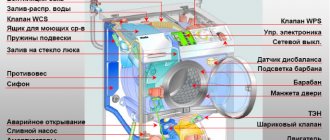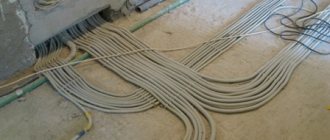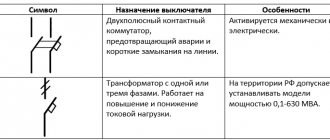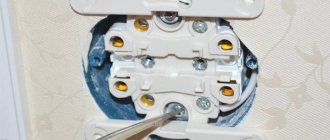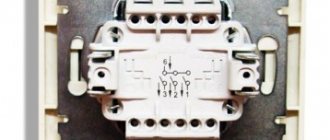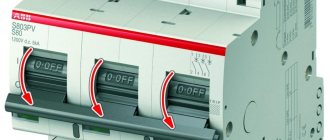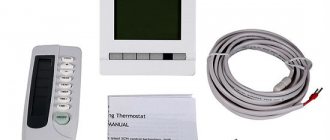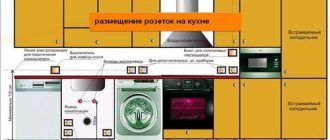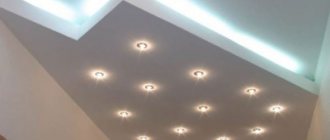Key Feature Differences
One obvious difference is the diameter of the fork entry holes. For a Euro socket it is 4.8 mm, while for a standard socket released during the USSR era it is 4 mm.
The Euro socket can be equipped with a grounding contact. For a number of electrical appliances, this is a prerequisite for operation.
A modern socket is significantly superior to its predecessor in its ability to pass greater current. The standard set of equipment in many apartments includes: a refrigerator, a TV, a computer, an air conditioner, an electric kettle, a microwave oven - you can’t count all the items.
When several devices operate simultaneously, old electrical networks simply cannot withstand the load. A Euro socket can withstand up to 32 A, versus 10 A of a Soviet-made socket.
Structurally, a Euro socket consists of a number of components that receive and transmit current to electrical appliances. The installation principle is also superior to options from the past. The internal structure of the socket is held in place by a metal frame.
For reliable fastening, a plastic box for the socket is mounted in the wall. Thanks to special antennae and bolts, the entire structure is securely fixed in the wall. The inside of the socket is covered with a decorative frame and cover.
Everyone is familiar with the unpleasant situation when, along with the plug, the socket itself is removed from the wall. With proper installation of the European socket, this situation is reduced to a minimum.
The Euro socket has a rather attractive appearance. Sometimes there are practically designer options on sale. This type of sockets is used for both indoor and outdoor installation.
If we talk about the pros and cons of European sockets, then the situation is as follows - a whole set of absolute advantages!
Standards for installing sockets and switches
As previously mentioned, there are no standards or rules for the installation of sockets and switches. “Eurostandard” is nothing more than a convention , since only safety precautions and ease of use are important here. This is confirmed by the Code of Rules for the Design of Residential and Public Buildings (SP 31–110-2003), the latest edition of which was published in 2003, and the Electrical Installation Rules, which were prepared taking into account all IEC standards, therefore the installation of electrical wiring should be carried out based on these recommendations. The following installation rules follow from the first:
- switches should be placed on the door handle side at a height of 1 m from the floor;
- the distance from the floor to the outlet should also be 100 cm, and its location does not matter.
Excerpts from the Electrical Installation Rules
- switches should be placed similarly to the instructions from the previous document, i.e. near the door handle at a distance of 1 m from the floor;
- the switch can also be located under the ceiling, if there is a switching cord that drops to the recommended level;
- in the kitchen, all power points must be at least half a meter from the gas pipeline and high enough from the floor;
- in bathrooms, electrical components should be installed at a distance of 60 cm from plumbing equipment and the same distance from the floor.
Euro sockets differ significantly from our products . The diameter of the pins and the distance between them in such a socket are somewhat larger. The current strength is also higher: euro – 10–16A, while domestic ones have half as much – 6–10A. Therefore, the first one is much more profitable, since you can connect several devices to it.
Installing a European socket
Important! Installation of the socket should only be done after the power supply has been turned off!
You can install the European socket yourself. To do this you need to know the basic rules. For convenience, the wires connected to the socket have different colors. Grounding is marked in green-yellow color. Phase - red or brown. Zero – blue and its shades.
Installation rules
- If the socket is installed in the bathroom, the socket must be separated from water sources by at least 600 mm.
- Installation height may vary. However, the maximum height from the floor is 1 m. The only exception is devices installed under the ceiling, such as a boiler.
- In kindergartens and other institutions for preschool children, the socket is located at a height of 1800 mm.
- The minimum installation distance from the gas pipeline is 500 mm.
- In residential premises, one socket is installed for every 4 square meters. In the hallway, one socket is installed for every 10 square meters.
How to install a socket
A number of tips taken from state standards. Part is advisory in nature, others are mandatory:
Socket installation height
- Sockets in schools and kindergartens are placed at a height of at least 1.8 meters. The same applies to switches.
- In public institutions and shops, it is recommended to install sockets at a height of 1.3 meters. The postulate is advisory in nature.
- For public buildings, it is required to install sockets for convenient use. Usually no higher than 1 meter from the floor. No minimum height specified. But it is written that it is allowed to install sockets in specially adapted fireproof baseboards.
- In workshops, the installation height is 0.8 meters on average; it can be increased to 1.5 meters if the power cord comes from above.
- It is prohibited to install sockets closer than 0.5 meters from the gas pipeline.
- It is prohibited to install sockets in storage rooms and utility rooms (belong to fire hazard class P-IIa) of apartments and private houses. Apparently, gasoline, kerosene and other flammable liquids are stored here.
- In the living room there is a 10 A socket with a 4-meter perimeter. If there is excess left, an additional outlet must be added. The moment is important when redevelopment. Let's say the partition separating the storage room is demolished. As a result, the perimeter of the room is increased and an outlet is added.
- In the kitchen, at least 4 sockets, 10 A each, are prescribed. If there is an electric stove, the power bus goes directly to the distribution panel (without branching). Moreover, the distance to the consumer is not standardized, but voltage distribution points cannot be placed above and below the sink. In the corridor there is a socket per 10 square meters of area. If it remains on top, a double socket is connected (with a corresponding increase in the cross-section of the power cable). What’s curious is that a double socket in a room is taken as one, and in the kitchen as two points (with appropriate adjustments to the cross-section of the cable being laid).
- It is not allowed to connect a switch and socket when the devices run along a single axis on both sides of the wall - exclusively for different apartments. Apparently, such actions are allowed within the living space.
In the presence of three wires for supplying electricity, the sockets are installed with a grounding blade (we assume this is meant by a protective contact). Rating - transmitted power - not less than 10 A. Equipment installed in rooms where children are located must have protective curtains that cover the sockets when the plug is pulled out.
Special requirements apply to rooms where water is used. It is prohibited to install electrical appliances closer than 60 cm from the entrance to the shower stall, at an equal distance from the bathtub, with few exceptions. In particular, in zones I and II, according to GOST R 50571.11, it is allowed to install water heaters and switches (under the ceiling) with a cord. At the same time, other requirements are not canceled. Providers connect using one of three security methods.
Individual isolation transformer
Sockets can be installed in the specified areas, but must be connected through an individual separating transformer. Unlike the standard one, this one does not lower or increase the voltage, but delivers it to the output in its original form. The current does not change. There are only losses due to reduced efficiency. The separating transformer provides galvanic current isolation. If you grasp the end of the secondary winding with your hand and put the second one under running water (attention! this must not be repeated in practice), nothing terrible will happen. A single subscriber is registered at such an outlet, and only a single outlet is registered at any transformer. It is not allowed to ground any part of the secondary circuit. The trick of combining the side lobe and the neutral wire will not work. This is strictly prohibited. But grounding in the bathroom is absolutely required. You will have to drag it from the panel or from another place, bypassing the transformer.
Approved electrical equipment for the bathroom
IPX1 protection
It is allowed to use equipment in bathrooms that indicates low supply voltage. Up to 50 V. In this case, the requirements for sockets are reduced. It is indicated that the housing’s protection of current-carrying parts is at least ip2X (insulation against penetration of external solid objects with a diameter of 12.5 mm or more; so that a finger does not get through), as for wiring, the insulation must withstand a voltage of at least 500 V for a minute. If you take a voltage of 220 V, the requirements are different. Sockets are installed exclusively within zone III (60 cm from the bathtub) and demonstrate protection class ipX1 (for public premises ipX5). These conditional measures must be observed when purchasing if you plan to connect sockets and switches in the bathroom.
Differential automatic
The third permitted method of installing an outlet in zone 3 (no closer than 60 cm from the bathroom) is the use of a differential circuit breaker. Please note that in this case it is prohibited to combine the ground terminal with the neutral wire. The housings of all electrical appliances are combined into a single bus that goes outside and is included in the general circuit of the apartment outside the bathroom. According to the rules, grounding is carried out simultaneously for the apartment; it cannot be combined with grounding wires. It is strictly forbidden to do this even in the area of the shield. These are the requirements for the TN-S and TN-CS systems. Praise to the owner who created the outline leading to the shield. The differential machine must respond to a leakage current not exceeding 30 mA.
Differential automatic
Features of installing a Euro socket in an old housing stock
One of the features of old-style residential buildings is the lack of grounding. When modernizing power supply networks, it is possible to install a neutral circuit.
In apartments of the old housing stock, the wiring is not designed for heavy loads. Installing a European socket without replacing the corresponding wiring will not solve the problem.
In case of replacing wiring and sockets, or when installing devices with high power consumption, it is necessary to consult with a specialist who has the appropriate approval.
Euro socket in the bathhouse
Installing any sockets in a bathhouse or steam room is prohibited. What to do if you want to install a refrigerator or TV for complete relaxation?
The location for installing the socket can be a dressing room. Installation height from 900 mm. Select the type of outlet for rooms with high humidity. Mostly with a protective cover. To increase safety, the European socket should be connected to a weak circuit breaker.
Source
Tips for locating sockets and switches
We have already said above that the installation height of sockets and switches according to the “Soviet” standard, in terms of convenience, has long been recognized by many as questionable. The notorious European standard began to be given more preference. Take, for example, the same sockets, or, more precisely, a block of them. It will not be as conspicuous as a bunch of sockets with tees and cords.
The same applies to switches that are located at the entrance to the room, at the level of a lowered human hand, at a height of 90 cm from the floor . Thus, it can be quickly found when entering a dark room. And in rooms with a greater length, it makes sense to install two pass-through switches at different ends.
Switches and sockets that do not have protection against current leakage “to ground” (RCDs, automatic circuit breakers) are not recommended for installation in toilets and bathrooms. The same applies to the socket for the washing machine.
